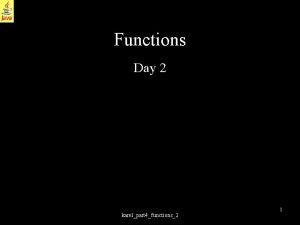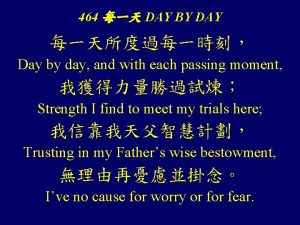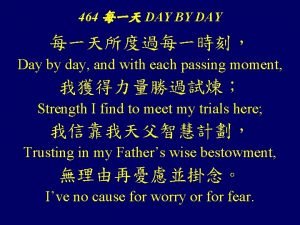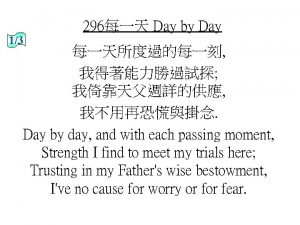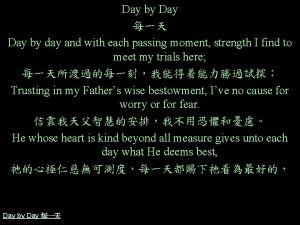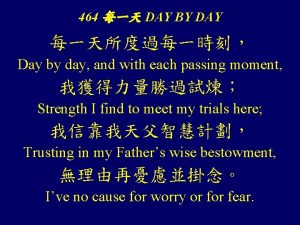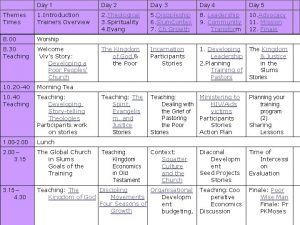Functions Day 1 karelpart 4functions1 1 Functions Functions











- Slides: 11

Functions Day 1 karel_part 4_functions_1 1

Functions • Functions return values or Objects. – Using a function allows the programmer to focus on other task. – Using a function allows the programmer to leave the details till later or someone else. karel_part 4_functions_1 2

Functions return – a value • • – An Object • A Robot • A Direction • Penguin Number Boolean value Words Direction – nothing – State of an Object • Height • Number of beepers karel_part 4_functions_1 3

Functions return a value • Functions that do NOT return a value are called procedures karel_part 4_functions_1 4

Functions • Functions may calculate a value, e. g. – Circumference – Volume – Distance between Objects – Elapse Time – Etc. karel_part 4_functions_1 5

Functions • Functions may return a known value, e. g. – Color – size karel_part 4_functions_1 6

User Define Function • In java (or Karel) new function can be created! public return. Type method. Name(parameters list) – return. Type indicate what is being returned by this function. – If return. Type is void, the function returns nothing and is called a procedure. – method. Name is the name of the function. – parameters list is any additional information needed to return the desired results! • Parameter list may be empty or contain pairs of words indicating the type (number, word, etc and its reference) karel_part 4_functions_1 7

Example • The following method has two parameters, s 1 and s 2 and returns one string that is built by concatenating s 1 & s 2 public String combine(String s 1, String s 2) { String str = s 1 + s 2; return str; } Sample call String ans = combine(“Computer”, “Science”); Sets ans to “Computer. Science” karel_part 4_functions_1 8

Another Example • The following method has three parameters, s 1, s 2 and s 3 and returns the sum s 1 + s 2 + s 3 public int sum(int s 1, int s 2, int s 3) { int ans = s 1 + s 2 + s 3; return ans; } Sample call int ans = sum(3, 20, 100); Sets ans to 123 int ans = sum(-13, 5); Sets ans to 5 karel_part 4_functions_1 9

Another Example • The following method has three parameters, s 1, s 2 and s 3 and returns the sum s 1 + s 2 + s 3 public int sum(int s 1, int s 2, int s 3) { return s 1 + s 2 + s 3; } Sample call int ans = sum(3, 20, 100); Sets ans to 123 int ans = sum(-10, -3, 0), 13, 5); Sets ans to 5 karel_part 4_functions_1 10

Homework #1 • Now would be a good time to do the first homework assignment for this section! • Now is also a good time to start the function project karel_part 4_functions_1 11
 Day 1 day 2 day 3 day 4
Day 1 day 2 day 3 day 4 Day 1 day 2 day 817
Day 1 day 2 day 817 Pgcps calendar a day b day
Pgcps calendar a day b day Haiku and
Haiku and Day to day maintenance
Day to day maintenance Physical science chapter 6 review answers
Physical science chapter 6 review answers I don't know tomorrow
I don't know tomorrow Timeline romeo and juliet
Timeline romeo and juliet Growing day by day
Growing day by day Observation of seed germination day by day
Observation of seed germination day by day Day by day seed germination observation chart
Day by day seed germination observation chart Role of transpiration
Role of transpiration












